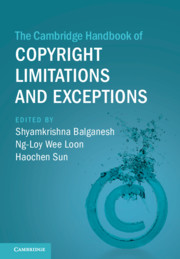Book contents
- The Cambridge Handbook of Copyright Limitations and Exceptions
- The Cambridge Handbook of Copyright Limitations and Exceptions
- Copyright page
- Contents
- Contributors
- Preface
- Part I The Theoretical Foundation of Copyright Limitations
- Part II Internationalizing Copyright Exceptions
- Part III Models of Copyright Exceptions
- 7 Debunking the Fair Use vs. Fair Dealing Myth: Have We Had Fair Use All Along?
- 8 Fair Use As an Advance on Fair Dealing? Depolarizing the Debate
- 9 The Changing Judicial Politics of Copyright Exceptions in the UK
- 10 “Fair Use” through Fundamental Rights in Europe: When Freedom of Artistic Expression Allows Creative Appropriations and Opens Up Statutory Copyright Limitations
- 11 Limitations and Exceptions in Copyright Law across the Taiwan Strait
- 12 A General Clause on Copyright Limitations in Civil Law Countries: Recent Discussion on Japanese-Style Fair Use Clause
- 13 Bridging Fair Dealing and Fair Use Concepts: Malaysia’s Transition to a Hybrid System
- Part IV Obvious and Hidden Values in the Working of Copyright Exceptions
- Part V Copyright Exceptions and Technology
7 - Debunking the Fair Use vs. Fair Dealing Myth: Have We Had Fair Use All Along?
from Part III - Models of Copyright Exceptions
Published online by Cambridge University Press: 15 January 2021
- The Cambridge Handbook of Copyright Limitations and Exceptions
- The Cambridge Handbook of Copyright Limitations and Exceptions
- Copyright page
- Contents
- Contributors
- Preface
- Part I The Theoretical Foundation of Copyright Limitations
- Part II Internationalizing Copyright Exceptions
- Part III Models of Copyright Exceptions
- 7 Debunking the Fair Use vs. Fair Dealing Myth: Have We Had Fair Use All Along?
- 8 Fair Use As an Advance on Fair Dealing? Depolarizing the Debate
- 9 The Changing Judicial Politics of Copyright Exceptions in the UK
- 10 “Fair Use” through Fundamental Rights in Europe: When Freedom of Artistic Expression Allows Creative Appropriations and Opens Up Statutory Copyright Limitations
- 11 Limitations and Exceptions in Copyright Law across the Taiwan Strait
- 12 A General Clause on Copyright Limitations in Civil Law Countries: Recent Discussion on Japanese-Style Fair Use Clause
- 13 Bridging Fair Dealing and Fair Use Concepts: Malaysia’s Transition to a Hybrid System
- Part IV Obvious and Hidden Values in the Working of Copyright Exceptions
- Part V Copyright Exceptions and Technology
Summary
Eleven decades ago, on December 16, 1911, the Imperial Copyright Act of 1911 received royal assent, codifying fair dealing for the first time, and thus explicitly recognizing it, in the imperial copyright legislation. Ten years later, the same fair dealing provision would appear in the Canadian Copyright Act and would remain the basis of the current fair dealing provisions. Tragically, what was supposed to be an exercise in the codification of a dynamic and evolving common law principle, usually referred to as “fair use,” ended up – with a few notable exceptions – in a hundred years of solitude and stagnation. Misinterpreting the 1911 Act, some courts and commentators in the UK and other Commonwealth countries adopted a narrow and restrictive view of fair dealing. Meanwhile, in the United States, fair use, the same common law concept that English and American courts developed, remained uncodified for most of the twentieth century. When the United States finally codified fair use in 1976, Congress left no doubt that the codification would not alter its common law basis and ought not hinder its flexibility and adaptability. Thus, toward the end of the twentieth century, a noticeable split in Anglo-American copyright law emerged: an open, flexible, and general fair use regime in the United States, and a seemingly rigid and restrictive fair dealing tradition in the Commonwealth countries.
Information
- Type
- Chapter
- Information
- The Cambridge Handbook of Copyright Limitations and Exceptions , pp. 111 - 139Publisher: Cambridge University PressPrint publication year: 2021
Accessibility standard: Unknown
Why this information is here
This section outlines the accessibility features of this content - including support for screen readers, full keyboard navigation and high-contrast display options. This may not be relevant for you.Accessibility Information
- 5
- Cited by
